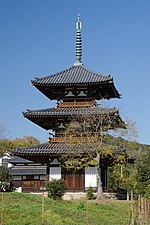| Hokki-ji 法起寺 | |
|---|---|
 | |
| Religion | |
| Affiliation | Shōtoku-shū |
| Deity | Jūichimen Kannon (Avalokiteśvara) |
| Location | |
| Location | 1873 Okamoto, Ikaruga-chō, Ikoma-gun, Nara Prefecture |
| Country | Japan |
| Architecture | |
| Completed | 638 |
| Website | |
| www.horyuji.or.jp/hokiji.htm | |

Hokki-ji or Hōki-ji (法起寺, the ‘temple of the Arising Dharma’) – formerly known as Okamoto-dera (岡本寺) and Ikejiri-dera (池後寺) – is a Buddhist temple in Okamoto, Ikaruga, Nara Prefecture, Japan. The temple's honorary sangō prefix is "Kōhonzan" (岡本山), although it is rarely used. The temple was constructed to honor Avalokitesvara, and an 11-faced statue of the goddess is the primary object of worship in the temple. Hokki-ji is often considered to be one of the seven great temples founded by Prince Shōtoku, but in fact the temple was not completed until some decades after his death. In 1993, it was registered together with Hōryū-ji as an UNESCO World Heritage Site under the name Buddhist Monuments in the Hōryū-ji Area.
History
Hokki-ji is located in Ikaruga, a town that has long been a focal point of Japanese Buddhism, and the area contains numerous other old temples related to Prince Shotoku, such as Hōrin-ji and Chūgū-ji. Hokki-ji is located on a foothill to the northeast of Hōryū-ji Tō-in. It is said that the temple lies atop the ruins of Okamoto no Miya (岡本宮) palace, wherein Prince Shōtoku had lectured on the Lotus Sutra, and that according to the prince's last will and testament, his son, Prince Yamashiro (Yamashiro no Ōe no ō) rebuilt the former palace as a temple. Excavation conducted around the temple grounds has revealed the remains of a building, the pillars of which were in direct contact with the earth (i.e. there was no foundation stone), confirming that another building had occupied the grounds prior to Hokki-ji.
The temple is laid out such that the main hall and the pagoda are aligned along the east-west axis, similar to the layout of Hōryū-ji Sai-in. However, Hokki-ji's main hall is in the west, and the tower is in the east; the opposite of Hōryū-ji Sai-in. This kind of temple layout has come to be known as "Hokki-ji style".
Cultural value
The only original 8th-century building remaining is the 24m-high three-storied pagoda, which is the oldest of its kind in Japan, and a National Treasure. The lecture hall is a 1694 reconstruction, and Shōten-do hall is an 1863 reconstruction.
The shrine contains a wooden 3.5m-tall 11-faced statue of Avalokitesvara that was constructed in the latter half of the 10th century. A copper image of a bodhisattva constructed in the latter half of the seventh century is currently entrusted to the Nara National Museum. Both of these items have been designated Important Cultural Properties.
Preservation
The three-story pagoda of Hokki-ji was repaired in 1262 and 1678. After the Meiji period, there have been two conservation projects, from 1898 to 1899 and from 1972 to 1975. Between 1972 and 1975, restorers completely demolished the building and then put it back again. Modern restorers removed the decayed mortise and tenon structures from the columns and beams and added new modules. They burned the date "shdwa 48" into these new modules for easier identification by later restorers. Fire prevention systems such as fire detection systems and water fire extinguishing systems have also been established. Records of the details of these works, including the results of investigations, plans and photographs were made into reports and published in 1975.
See also
References
- Schumacher, Mark. "Shotoku Taishi".
Couriously, there is a Shingon deity in Japan known as Hōki Bosatsu 法起菩薩 ...written with exactly the same as the characters of Hōkiji Temple, meaning "arising Dharma" or "awakening knowledge."
- "4. State of preservation/conservation".
- Lothar Ledderose (1998). Ten Thousand Things -- Module and Mass Production in Chinese Art. Princeton, New Jersey: Princeton University Press. pp. 121–127. ISBN 9780691009575.
External links
34°37′22″N 135°44′46″E / 34.62278°N 135.74611°E / 34.62278; 135.74611
| Buddhist temples in Japan | |||||||||||||
|---|---|---|---|---|---|---|---|---|---|---|---|---|---|
| Japanese Buddhist architecture |
| ||||||||||||
| Schools and objects of worship |
| ||||||||||||
| Other elements |
| ||||||||||||
- Buddhist temples in Nara Prefecture
- World Heritage Sites in Japan
- National Treasures of Japan
- Important Cultural Properties of Japan
- Pagodas in Japan
- Historic Sites of Japan
- Prince Shōtoku
- 638 establishments
- Religious buildings and structures completed in the 630s
- 7th-century Buddhist temples
- 7th-century establishments in Japan